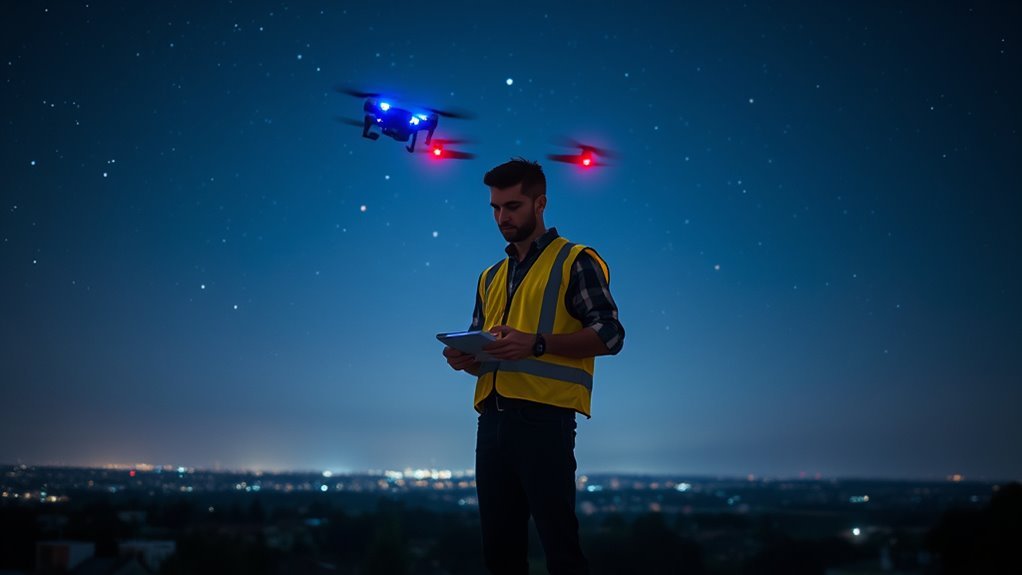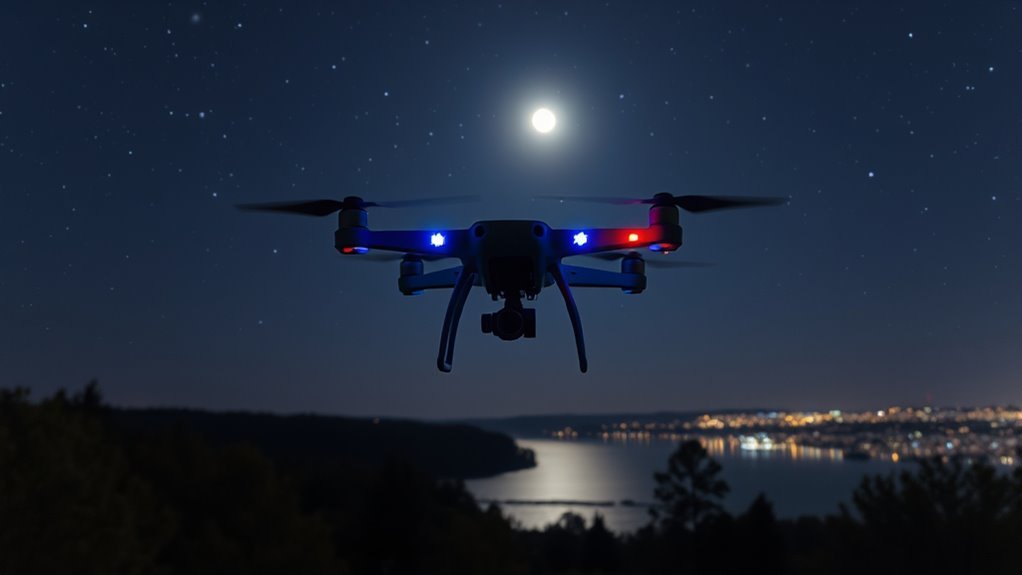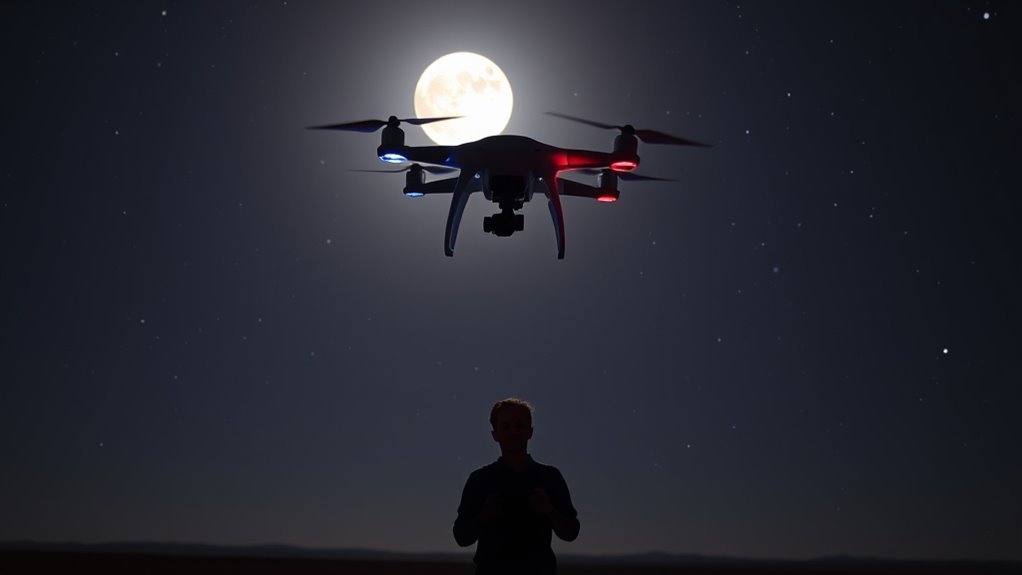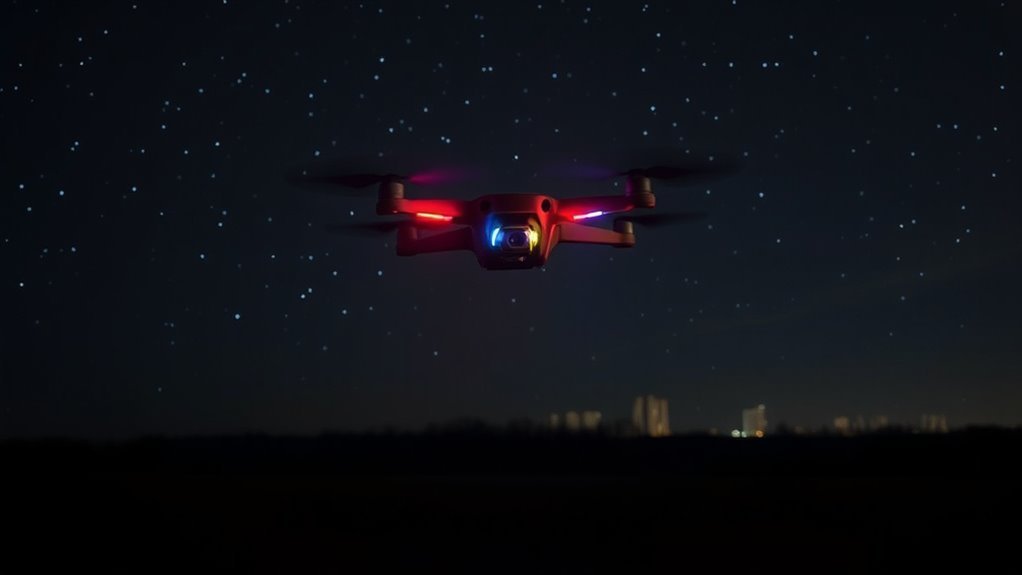To legally fly a drone at night, you must follow FAA regulations. Verify your drone has anti-collision and position lights, and maintain visual line-of-sight during flight. You’ll need a Part 107 certification for commercial operations, and prior authorization if flying in controlled airspace. Familiarize yourself with local laws and conduct pre-flight checks. Staying aware of your surroundings is vital. There’s plenty more to reflect on for a safe night flight experience if you want to know more.
Understanding FAA Regulations for Night Flying

Before you take to the skies at night with your drone, it’s essential to understand the FAA regulations that govern nighttime flying. First, you need to verify your drone is equipped with proper lighting for visibility; this enhances safety and allows others to see your craft. Night vision capabilities can be beneficial but aren’t a substitute for compliance. You must also maintain visual line-of-sight with your drone throughout the flight. Additionally, operating in controlled airspace requires prior authorization, so check local airspace requirements. Following these regulations not only keeps you compliant but also promotes drone safety for everyone involved. Embracing these guidelines allows you to enjoy the freedom of night flying while minimizing risks.
Obtaining the Necessary Certifications

While flying a drone at night can be exhilarating, obtaining the necessary certifications is crucial for compliance and safety. To guarantee you’re ready for night flights, focus on these key steps:
- Complete Night Flight Training: This specialized training prepares you for unique challenges and enhances your skills in low-light conditions.
- Obtain Drone Pilot Certifications: Confirm you have your Part 107 certification, as it’s mandatory for commercial operations, including night flying.
- Stay Informed on Regulations: Regularly check for updates from the FAA to keep your certifications valid and understand any new requirements.
Essential Lighting Requirements for Night Flights

When flying a drone at night, proper lighting is essential for safety and compliance. You need to guarantee your drone has adequate drone illumination to maintain night visibility. The FAA mandates specific requirements for lights, which help you and others see the drone in low-light conditions.
| Light Type | Purpose |
|---|---|
| Anti-collision lights | Enhance visibility |
| Position lights | Indicate orientation |
| Strobe lights | Provide additional visibility |
| Landing lights | Assist during landing |
Tips for Maintaining Situational Awareness
To guarantee safe night flights, maintaining situational awareness is essential, especially since visibility can be limited. Here are some tips to enhance your night vision and spatial awareness:
Maintaining situational awareness is crucial for safe night flights, especially when visibility is reduced.
- Use Night Vision Tools: Invest in goggles or screens that amplify low-light conditions, allowing you to see obstacles and other aircraft more clearly.
- Practice Drone Control: Regularly fly your drone during twilight to familiarize yourself with how it operates in reduced light.
- Stay Aware of Surroundings: Always keep an eye on your surroundings, including other drones and wildlife, to prevent accidents and guarantee a smooth flight.
Best Practices for Safe Night Operations
Maintaining situational awareness is just the starting point for safe night operations. Before you take to the skies, make certain you conduct thorough pre-flight checks. Verify that your drone’s lights are functioning properly; they’re essential for visibility. Consider using night vision equipment to enhance your ability to see obstacles and maintain control.
Always fly in well-lit areas whenever possible, and keep your drone within visual line of sight. Familiarize yourself with the area you’re flying over, as landmarks can be harder to identify at night. Stay updated on local regulations regarding night operations, and always have a plan for unexpected circumstances. By following these best practices, you can enjoy the freedom of flying at night while prioritizing safety.
Frequently Asked Questions
Can I Fly a Drone at Night Without a Part 107 Certification?
You can’t fly a drone at night without proper certification under current drone regulations. For night visibility, you’ll need specific lighting and adherence to safety guidelines, ensuring you fly responsibly while enjoying your freedom.
Are There Specific Areas Where Night Flying Is Prohibited?
In your quest for aerial freedom, remember that specific areas, like no fly zones, can tether your ambitions. Always check local regulations; they can ground your night flying plans faster than a sudden storm.
What Are the Penalties for Flying a Drone at Night Illegally?
If you fly a drone at night illegally, you could face hefty fines and penalties from enforcement agencies. Staying informed about regulations helps you avoid these consequences while enjoying your freedom to fly responsibly.
Do I Need a Spotter for Nighttime Drone Flights?
Flying a drone at night without a spotter’s like traversing a dark forest alone; you’ll miss crucial cues. For flight safety, having a spotter enhances your night vision and helps guarantee compliance with regulations.
How Can I Improve My Night Flying Skills?
To improve your night flying skills, practice regularly in low-light conditions. Utilize night vision tools and focus on mastering your drone’s controls. Consistent flight practice will enhance your confidence and proficiency during nighttime operations.

